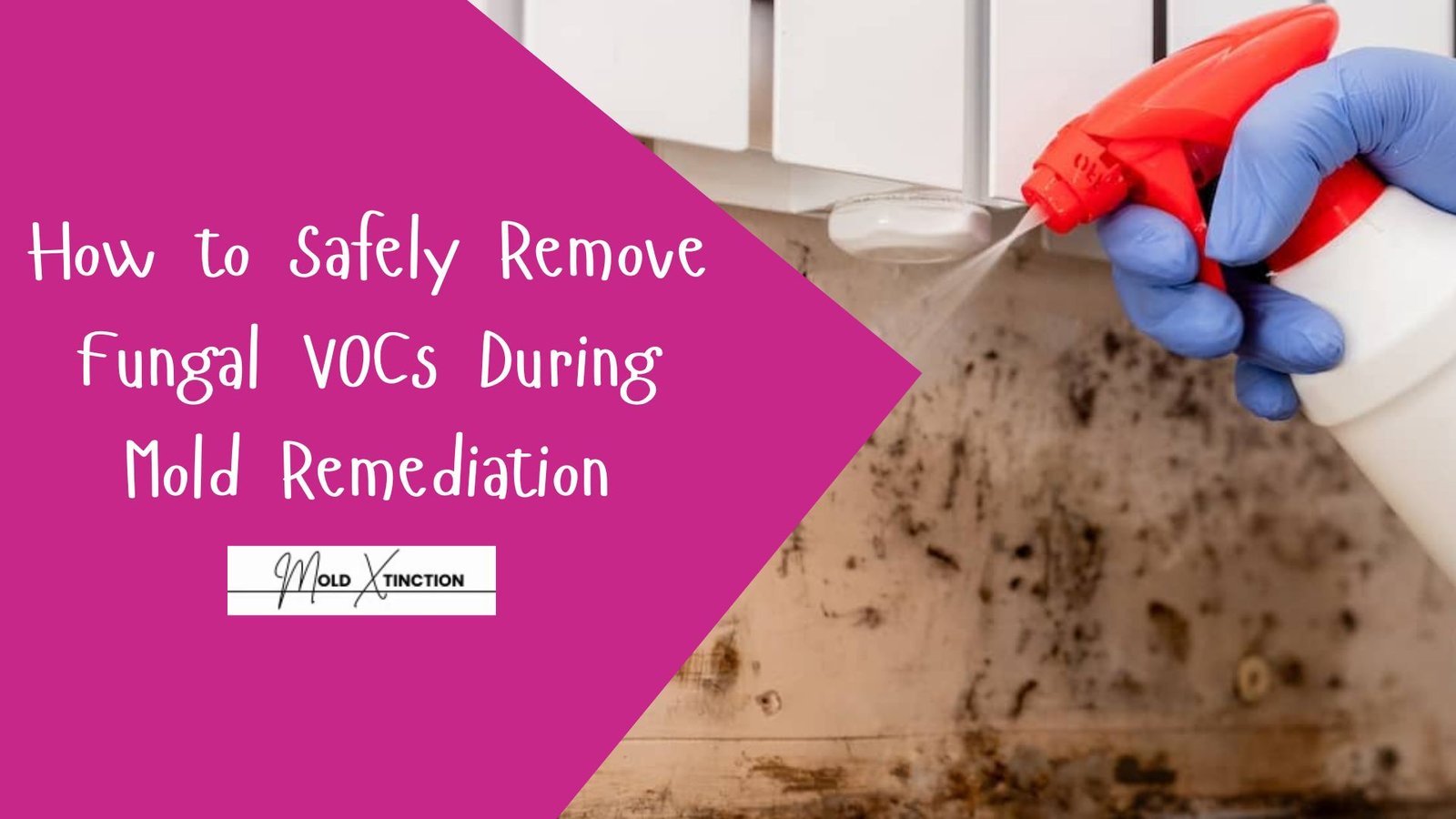Ever wondered how to safely remove fungal VOCs during mold remediation? It isn’t a big deal; it is a DIY thing. You can do it by yourself.
Many homes have a big problem with mold. But did you know that mold doesn’t just grow on walls and stink? It releases poisonous gases into the air, too. These are called fungal VOCs.
They can make you sick. You should get rid of these bad gases when you’re cleaning mold in your house.
After reading this article, you’ll know the safe ways to remove fungal VOCs during mold remediation.
We’ll use plain language and break down the tips into small and easy-to-understand steps for you.
What Are Fungal VOCs?
VOCs, meaning Volatile Organic Compounds, are gases released by mold during growth and expansion.
The compounds are colorless, which the naked eye cannot see; that is, you can’t see these compounds, but you can commonly notice them by their strong and unpleasant smell.
Fungal VOCs have many descriptions, including musty, sour, or earthy odors, like the smell of damp basements, wet wood, or old paper.
Such odors are indications that there’s mold in the environment, although they’re not yet visible on surfaces.
Fungal VOCs are by-products of mold metabolism; they can produce bad indoor air quality, resulting in headaches, allergic symptoms or respiratory distress of sensitive people after prolonged exposure.
Some fungal VOCs can cause:
- Headaches
- Dizziness
- Breathing problems
- Eye and throat irritation
- Trouble thinking clearly
When you have mold growth in your home, you probably have fungal VOCs in the air too. It’s not enough to clean the mold. You have to clean the air too.
How to Safely Remove Fungal VOCs During Mold Remediation

Step 1: Stop the Mold at Its Source
You have to prevent the mold from spreading before you clean the air. Mold grows fast in damp and dark areas. It can hide in areas you may not notice immediately. Check your home to ensure it is dry without any leakages of water either below the sink or near the toilet. Look at the roofing material; check whether there is any broken pipe or water leakage.
Check the basement or behind your washing machine too. When you spot that something is wet, have it fixed early.
As long as the water does not stop, mold will continue to grow. After all is dry and secure then you can start cleaning the air inside your house.
Do:
- Repair immediately
- Use fans or dehumidifier
- Discard wet or moldy items like carpets or boxes
Mold growth stops new VOCs.
Step 2: Wear the Right Gear
You have to protect yourself when cleaning mold. You can get sick from mold even if you can’t see it. As the mold expands, it emits small fungal VOCs gases.
These gases is not safe for breathing because when they enter the air, what you will start observing is pains in your eyes, nose, throat, or lungs.
The effect will be that you will start experiencing a cough, feel exhausted, or experience a headache in some cases. On the safe side, put a mask on your nose and mouth.
Skin and eyes are covered with gloves and goggles. Windows open, if possible, to allow fresh air to enter. Do not ever touch mould with your bare hands. Be careful whenever you are cleaning mold..
Wear:
- a powerful mask (such as N-95 or P100)
- Protective goggles
- Gloves
- Fine shirt with long sleeves and trousers of long length
Never clean mold without this gear. It protects your lungs, skin and eyes.
Step 3: Seal Off the Area
To prevent VOCs from spreading, you must seal the room with the mold. This contains the bad gases and moulds to other parts of your house. you can close the door and place a towel at the bottom to block the air.
If the room has vents, cover them too. Do not enter and leave the room so often and frequently as the mold is not allowed to spread to other sections of the house.
It should be covered with plastic sheets or the tape, in case you have any. Having the room shut will ensure the rest of your house is safeguarded and the air is less polluted.
What to do:
- Close the room windows and doors of the room
- Any open spaces should be blocked with plastic sheets
- Switch off your central air or the heating and cooling system to prevent the spread of mold through the ducts
This is done to maintain the security of your house.
Step 4: Use HEPA Air Purifiers
What is HEPA all about, and what does it do? A HEPA is just an air purifier device created to help you purify the air in your house.
HEPA filter Tiny objects in the air such as dust, spores of molds, and harmful gases produced by molds referred to as fungal VOCs can be trapped in the high-efficiency particulate air (HEPA) filter.
These mold gases may cause you sick.
They are trapped on the HEPA filter so you don’t inhale them. If you have mold in your house, a HEPA air purifier can make the air filters safe to breathe. It’s a smart device to use after you remove the mold.
Choose an air purifier with:
- True HEPA filter
- Activated carbon filter – assists in eliminating offensive odors and poisonous gases in the air.
- High Clean Air Delivery Rate
Place the purifier in the moldy room. Let it run as you clean and several hours after. This clears the air.
Step 5: Activated Charcoal or Baking Soda
These are easy to use to absorb VOCs in the air.
How to use:
- Put some bowls with baking soda or activated charcoal in the room to absorb moisture and nasty smells.
- Leave them out for several days
- Replace them every few days for best results
They will not clear all the gases but they will make the air smell better and cleaner.
Step 6: Allow Fresh Air to Always Have Access into the Room
After mold removal, open the room to fresh air. This will remove leftover VOCs.
Do this only when:
- Mold is cleaned up
- Weather is dry
- There is no mold outside the home
Use open windows and doors to get fresh air.
Blow the bad air out using fans.
Step 7: Use Safe Cleaning Products
VOCs can be triggered by some cleaning products. These products are highly fragranced and contain toxic chemicals.
They can put more bad gases in the air and when you use them it may be harder to breathe and it can make your health bad.
When cleaning mold, avoid strong smelling cleaners. Rather than that use mild and Non-toxic compounds such as soap and water or vinegar. When cleaning, windows must be open to allow fresh air.
This will help in keeping the air clean and safe whilst working. Be cautious of what you use at home.
Use:
- White vinegar
- Baking soda
- Hydrogen peroxide
Such are not hazardous and they will not emit poisonous gases into your house.
A lot of us love combining one leaving products with another, its advisable that you should stop. Combining vinegar and bleach or other cleaners may result in deadly fumes.
Step 8: Use a Dehumidifier
Keeping your home dry will prevent mold and VOCs from coming back.
Place a dehumidifier in:
- Basements
- Bathrooms
- Kitchens
- Other damp areas
Maintaining the air in your house at less than 50 percent humidity is advisable. This will increase the difficulty of mold growth.
Step 9: Clean or Remove Items That Absorbed VOCs
Soft items like curtains, carpets and sofas can absorb mold VOCs.
Do this:
- Wash them in hot water (if safe)
- Let them dry completely
- If the smell stays, consider replacing them
This will reduce the smell and gases in your home.
When Do I Need to Call a Professional Mold Remediation Service?
When you have a large mold problem or a bad odor that just won’t disappear, then you require assistance
The horrible odor might be an indication of mold or toxic fumes within the atmosphere. Mold specialists are aware of how to detect it and eliminate to safely.
They use special equipment and wear protective gear to safety proof themselves. They are also aware of ways of cleaning up the air and preventing the recurrence of the mold.
Trying to manage a severe mold issue is dangerous. Some experts should handle it so you and your home stay safe and healthy.
They can:
- Test your air for mold and VOCs
- Find hidden mold
- Clean and seal the area properly
- Use commercial-grade air cleaners
Never try to clean up big mold problems yourself. Mold is hazardous and more so when it’s widespread.
Inhaling mold will make you sick. It can cause coughing, sneezing and at worst, breathing difficulties.
Mold is also hard to see and if you miss a spot, it can grow back in no time. It will get worse when a person tries to clean it without the right tools or knowledge. It’s better to leave it to the pros.
A professional mold removal team knows how to make the job safe and thorough. They wear special clothes and have the right tools.
Health and home are important. Not worth the risk so whenever mold is big, call a pro.
Helpful Guide: How to Prevent Mold in Poorly Designed Houses
Conclusion
These are toxic gases that are released in the air by mold as fungal VOCs. They can make you sick and long term health issues. Just wiping off mold is not enough.
You need to clean the air too. To be on the safe side, fix leaks and prevent mold, use air purifiers and non-toxic cleaners, wear protection and close the room.
When mold in your house is severe, then you should always call a professional mold remediation company. They have the right equipment and expertise to make your home safe again.
A clean air and mold free home is important to your health and your family’s health. Why wait till it gets worse, act now and breathe easy again.


